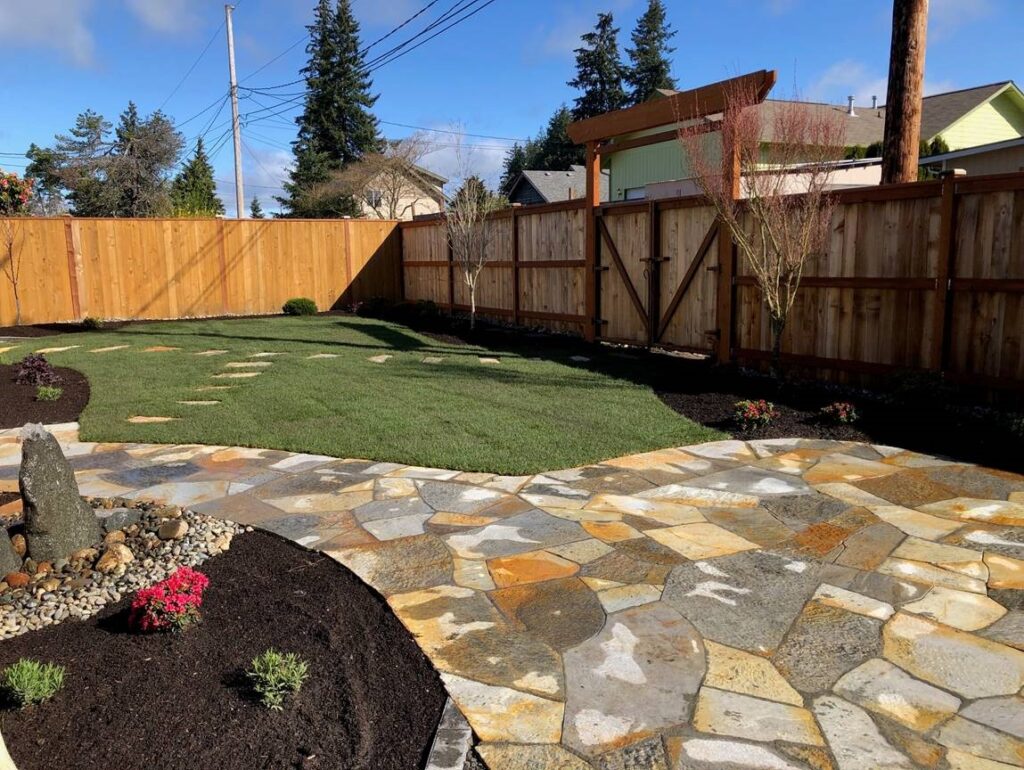What is a Flagstone Patio?
A flagstone patio is a great addition to any outdoor space. It is a patio made from the natural stone known as flagstone, which is a type of sedimentary rock. Flagstone is a popular choice for patios because of its durability, wide variety of colors, and unique texture.
Flagstone patios can be wet-laid or dry-laid. Wet-laid flagstone patios involve pouring a concrete base and then placing the flagstones on top of the wet concrete. This method provides a strong and stable base for the patio. Dry-laid patios, on the other hand, involve placing the flagstones directly onto a bed of sand or gravel. This method is more affordable and easier to install, but may not be as durable as wet-laid patios.
Flagstones come in a variety of shapes, sizes, and colors, giving homeowners a lot of options to choose from. Irregular shapes and sizes are often preferred for a rustic look, while more uniform shapes and colors give a patio a modern and clean look. The cost of flagstone varies depending on the type of stone and the region in which it is being sourced.
The cost of a flagstone patio largely depends on the size of the patio and the type of stone used. On average, a 200-square-foot flagstone patio can cost between $2,000 and $4,000, while a larger patio can cost upwards of $10,000. Other factors that contribute to the cost include labor rates, installation method, and quality of materials.
Despite the potential expense, a flagstone patio is a worthwhile investment. It adds value to a home and provides a beautiful outdoor living space that can be enjoyed for years to come. It is a durable material that can withstand heavy foot traffic and extreme weather conditions. In addition, the variety of shapes and colors available make it a versatile option for any outdoor space.
Overall, a flagstone patio is a great way to enhance the look and functionality of any outdoor space. With a variety of options and styles available, homeowners can create a unique and beautiful outdoor living area that fits their personal preferences and budget.
Advantages of a Flagstone Patio
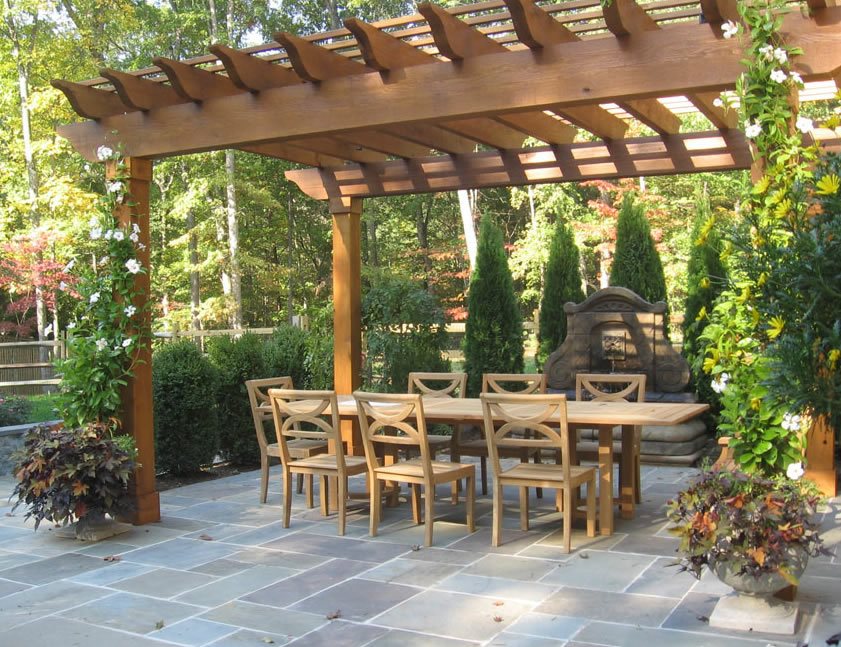
A flagstone patio is a beautiful and functional addition to any outdoor living space. Not only does it provide an inviting area for outdoor entertaining, but it also adds value to a home. Here are some advantages of having a flagstone patio:
Durable Material: Flagstone is a sedimentary rock that is naturally durable and can withstand heavy foot traffic and extreme weather conditions. Unlike other materials, such as concrete or wood, flagstone does not crack easily, making it a long-lasting option for outdoor patios.
Variety of Shapes and Colors: Flagstones come in a wide variety of shapes, sizes, and colors, allowing homeowners to choose the perfect design to complement the style of their home and outdoor space. Irregular shapes and sizes are often preferred for a more rustic look, while more uniform shapes and colors give a patio a modern and clean look.
Easy Maintenance: Flagstone patios require minimal maintenance, making them a convenient option for homeowners. The natural texture of the stone provides good traction, reducing the risk of slips and falls, and the stones are easily cleaned with soap and water.
Cost-Effective: While the initial cost of installing a flagstone patio may be higher than other materials such as concrete pavers, it is a cost-effective option in the long run. The durability of the material means that it will not need to be replaced as frequently as other options, such as wooden patios, saving homeowners money over time.
Adds Value to a Home: Flagstone patios are a desirable feature for potential home buyers, adding value to a home and increasing its curb appeal. A well-manicured flagstone patio can make a significant difference in the aesthetic appeal of a property.
Overall, a flagstone patio is a worthwhile investment for any homeowner looking to create a beautiful outdoor living space that will stand the test of time. With its durability, variety of shapes and colors, easy maintenance, cost-effectiveness, and ability to add value to a home, it’s easy to see why flagstone patios are such a popular choice.
Types of Flagstone Patios
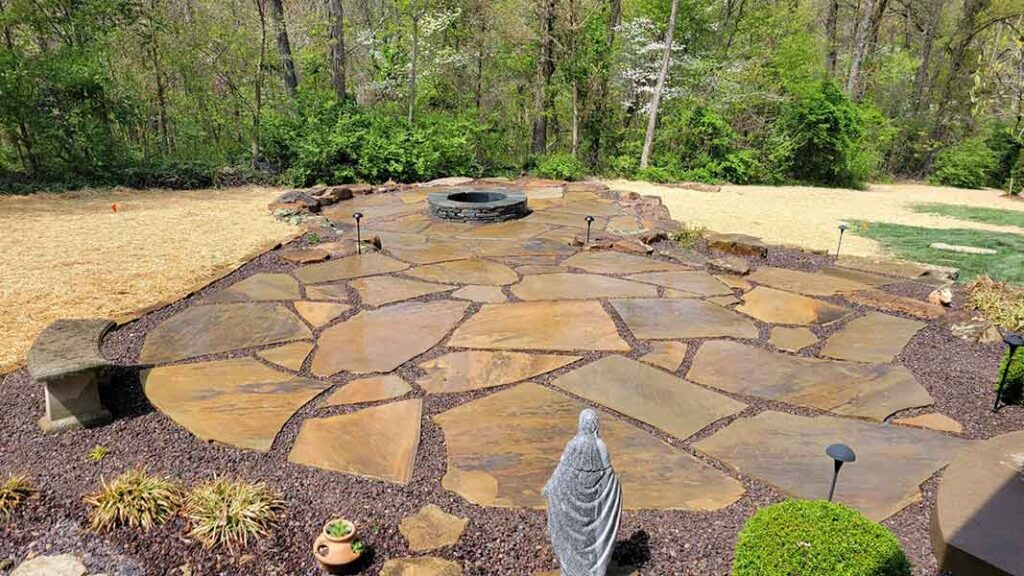
When it comes to creating an outdoor living space, there are few options that offer the natural beauty and durability of a flagstone patio. Flagstone is a sedimentary rock that is formed from layers of sediment and minerals that have settled and hardened over time. One of the main benefits of using flagstone for a patio is its versatility, as it can be used in a variety of ways to create a unique and personalized outdoor environment. In this article, we will take a closer look at some of the different types of flagstone patios available and their individual characteristics.
Dry-Laid Patios: The dry-laid method involves laying the flagstones directly onto a bed of crushed stone and sand, without the use of any mortar or cement. This method allows for flexibility in the design, as the stones can be easily relocated or replaced without causing any damage to the patio. Dry-laid patios also require less maintenance, as they do not have the potential for cracking or heaving that can occur with a mortared patio.
Wet-Laid Patios: Wet-laid flagstone patios are installed using a mortar or cement mix to hold the stones in place. This method provides a more secure and stable surface, making it a better option for areas with heavy foot traffic or for larger patios. Wet-laid patios also offer a wider variety of design options, as the stones can be cut and shaped to fit specific patterns or shapes.
Natural Stone Patios: Natural stone patios are made from a variety of different types of stone, including flagstone, slate, and limestone. These types of patios offer a more organic and natural look, with their irregular shapes and natural coloring.
Paver Patios: Paver patios are made from pre-cut stone or concrete pavers that are arranged in a predetermined pattern. While not technically a flagstone patio, paver patios offer similar durability and design options.
Regardless of the type of flagstone patio chosen, there are a few key factors to consider when planning and designing the patio. These include the size and shape of the patio, the type of stone to be used, and the installation method. Personal preferences and budget will also play a role in the decision-making process.
In conclusion, flagstone patios are a versatile and durable option for any outdoor living space. With a variety of options available, including dry-laid, wet-laid, natural stone, and paver patios, homeowners are sure to find the perfect design for their specific needs and budget.
Wet-Laid Flagstone Patio
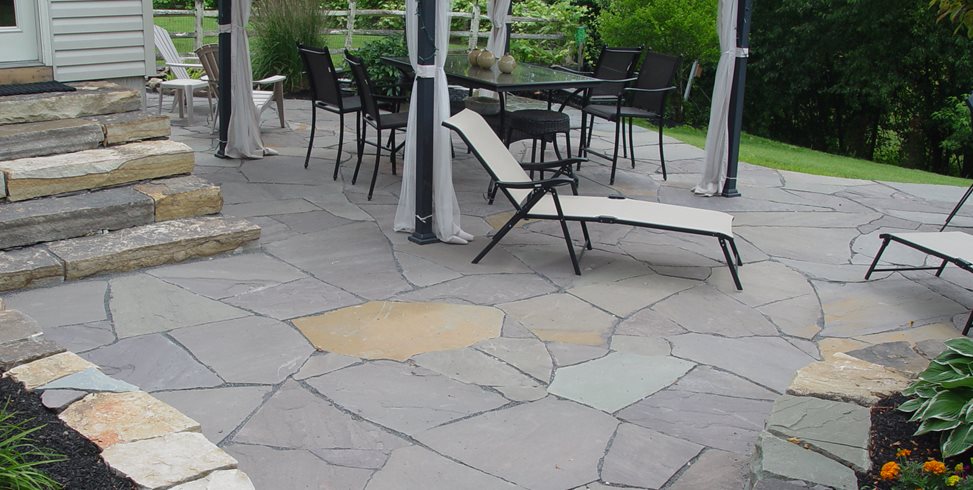
A wet-laid flagstone patio is a beautiful and durable outdoor living space option that can transform any backyard into a relaxing oasis. This method involves using a mortar or cement mix to hold the stones in place, offering a more secure and stable surface for heavier foot traffic or larger patios.
One of the main benefits of a wet-laid flagstone patio is the wide variety of design options it offers. Because the stones can be cut and shaped to fit specific patterns or shapes, homeowners can get creative and customize their patio to suit their unique style. The colors, textures, and patterns of the stones used can also be tailored to fit the overall aesthetic of the home and surrounding landscape.
Wet-laid flagstone patios are also known for their durability. The mortar or cement mix used to hold the stones in place creates a strong bond that can withstand even harsh weather conditions. This means that homeowners can enjoy their patio for years to come without worrying about costly repairs or replacements of any patio things like patio cushions, patio table and etc.
When considering the installation of a wet-laid flagstone patio, the cost is also a factor to keep in mind. While it may be a more expensive option than a dry-laid patio or a paver patio, the use of high-quality materials and skilled labor ensures that homeowners get the most bang for their buck. Additionally, the added durability and aesthetic appeal of a wet-laid flagstone patio increase the overall value of the home.
In conclusion, a wet-laid flagstone patio is a beautiful and durable option for those looking to enhance their outdoor living space. Offering a wide variety of design options and unparalleled durability, this method of installation ensures that homeowners can enjoy their patio for years to come. While it may come with a higher price tag, the investment is well worth it in the long run.
Dry-Laid Flagstone Patio
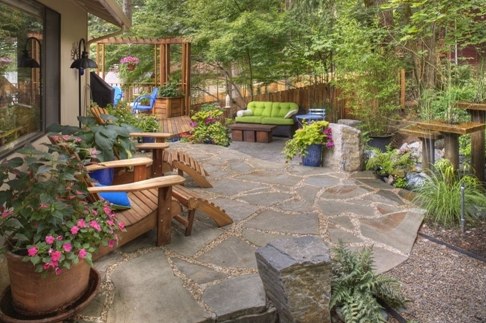
If you’re considering adding a flagstone patio to your outdoor living space, you may be wondering about the different options available to you. One popular choice is a dry-laid flagstone patio, which is constructed without using any mortar or concrete to hold the stones in place.
One of the primary advantages of a dry-laid flagstone patio is that it’s more affordable than a wet-laid patio because it requires less labor and materials. This makes it a great option for homeowners who want a beautiful outdoor space without breaking the bank.
Another benefit is that a dry-laid flagstone patio can be easier to maintain. Because there are no joints or seams between the stones, there’s less chance of weeds or grass growing between them. This means less time spent pulling weeds and more time enjoying your patio.
Dry-laid flagstone patios also offer a wide variety of design options. The stones can be arranged in various patterns, such as a traditional grid or a more random layout. You can also mix and match different types of stones for a unique look.
When planning a dry-laid flagstone patio, it’s important to consider the type of stone you want to use. Sedimentary rocks like sandstone and limestone are popular choices because they’re durable and come in a variety of colors and shapes. However, other types of stone, such as granite or slate, can also be used.
The installation process for a dry-laid flagstone patio involves excavating the area where the patio will be located and preparing a sturdy base for the stones. Then, the stones are laid in place, usually with some type of sand or gravel between them to help stabilize them. This is a job that can be done by a skilled DIYer or by a professional contractor.
In terms of maintenance, a dry-laid flagstone patio should be swept or hosed down regularly to remove debris and prevent staining. Sealing the stones can also help protect them from water damage and prolong their lifespan.
Overall, a dry-laid flagstone patio is a cost-effective and stylish option for homeowners looking to upgrade their outdoor living space. With its durability and low-maintenance qualities, it’s a great choice for busy families and anyone looking to enhance their home’s curb appeal.
Factors That Influence Cost of a Flagstone Patio

Flagstone patios are a beautiful addition to any outdoor living space and can significantly enhance the functionality and aesthetics of your home. However, when considering the installation of a flagstone patio, one of the most important factors to consider is the cost. The cost of a flagstone patio can vary significantly based on a variety of factors, including the quality of materials used, the size and complexity of the project, and the installation process utilized.
One of the most significant factors that influence the cost of a flagstone patio is the type and quality of the stone used. Natural stone can be expensive, and the cost can vary based on factors such as availability, color, and durability. For example, a high-quality stone such as sandstone or granite will typically cost more than a lower quality limestone or slate.
Another crucial factor that can influence the cost of a flagstone patio is the size and complexity of the project. Larger patios will require more materials, which will lead to higher costs. Additionally, if the project requires additional features such as stairs or retaining walls, the cost will increase accordingly. The shape of the patio can also impact the cost, as irregular shapes may require more materials and labor to install.
The installation process utilized is also a critical factor that can impact the cost of a flagstone patio. Wet-laid flagstone patios require a more intricate installation process, which often leads to increased labor costs. On the other hand, dry-laid flagstone patios are more affordable due to the reduced labor and materials required for installation.
Personal preferences can also impact the cost of a flagstone patio. Homeowners who prefer a more elaborate design or unique patterns may require more materials and additional labor, leading to increased costs. Additionally, some homeowners may prefer a specific type of stone or color, which may not be widely available or may be more expensive.
In conclusion, the cost of a flagstone patio can vary significantly based on a range of factors. To ensure that you receive an accurate estimate for your project, it is essential to work with a reputable contractor who can provide an itemized list of costs. By considering these factors carefully and understanding the installation process, homeowners can create a stunning flagstone patio that meets their functional and aesthetic needs while staying within their budget.
Square Footage of the Space
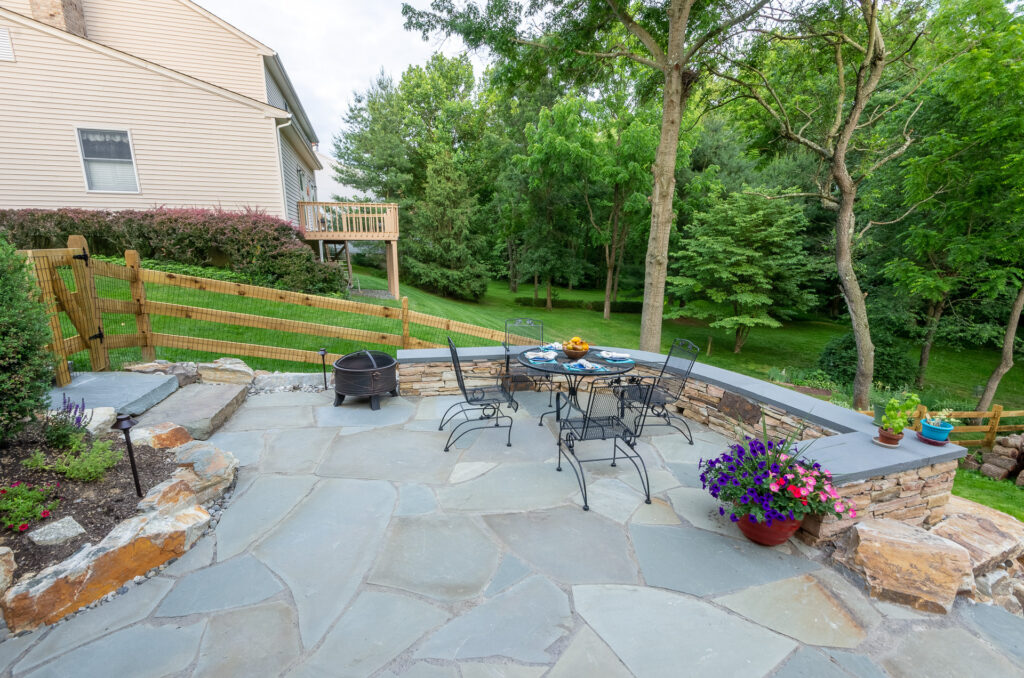
When it comes to planning and designing an outdoor living space, one of the most important considerations is the square footage of the area. The size of the space will affect not only the overall cost of the project but also the options for layout, furniture, and amenities.
One of the first steps in planning any outdoor living space is determining the size of the area. This can be done by measuring the length and width of the space, and then multiplying the two numbers together to get the total square footage. For example, a patio that is 20 feet long and 15 feet wide would have a total square footage of 300 square feet.
Once the square footage of the space has been determined, homeowners can begin to consider the layout and features they want to include. For smaller spaces, such as a 200-square-foot flagstone patio, it may be necessary to prioritize certain features over others. This could mean choosing a smaller dining table or opting for a fire pit instead of a full-sized outdoor fireplace.
In larger spaces, there may be more flexibility when it comes to layout and amenities. For example, a 400-square-foot patio could comfortably accommodate a larger dining table, lounge area, and outdoor kitchen. Additionally, larger spaces may allow for the inclusion of features such as a pool or hot tub, which would not be practical in smaller areas.
Aside from the features and layout of the space, the square footage of the area will also impact the overall cost of the project. This is because the cost of materials and labor will increase with the size of the space. It is important for homeowners to understand their budget limitations and prioritize their needs and wants accordingly.
In conclusion, the square footage of an outdoor living space is a crucial factor in the planning and design process. Homeowners should carefully consider the space available and prioritize their needs and wants in order to create a functional and enjoyable outdoor living area that fits within their budget.
Quality and Type of Materials Used
When it comes to building a flagstone patio, one of the most important factors to consider is the quality and type of materials used. A patio is a permanent fixture that will be enjoyed for years to come, so it’s crucial to invest in materials that are not only durable but also aesthetically pleasing.
Natural stone is a popular choice for many homeowners because of its unique beauty and longevity. Sedimentary rock, such as sandstone, limestone, and granite, are often used in flagstone patios because they are hard-wearing and able to withstand the elements. These stones can be found in a variety of colors and shapes, making them a versatile choice for any outdoor space.
Concrete pavers are another option for those looking for a more affordable option. They are made from a mixture of sand, cement, and water which is then poured into a mold. Once set, they can be arranged in a variety of patterns to create a unique look.
Regardless of the type of stone you choose, it’s important to ensure that you’re using high-quality materials. Inferior materials may be cheaper, but they won’t last as long as their more expensive counterparts. Low-quality stones may also be more prone to chipping or cracking, which can be a safety hazard.
In addition to choosing the right type of stone, the installation method will also impact the durability and longevity of your patio. Wet-laid flagstone patios are laid on a concrete slab and mortared in place. This method provides a permanent solution with the strength and stability of concrete.
On the other hand, dry-laid patios use a layer of compacted gravel with sand on top to create a stable base for the stones. The stones are then arranged on top of the sand and interlocked to create a stable surface. While this method is less permanent than wet-laid installation, it allows for easy repairs or replacements if a stone is damaged.
Ultimately, the cost of a flagstone patio will depend on the square footage, quality of materials, and installation method. However, investing in high-quality materials and a professional installation will ensure that your patio is not only beautiful but also durable enough to withstand the test of time.
Labor Costs Involved in Installation
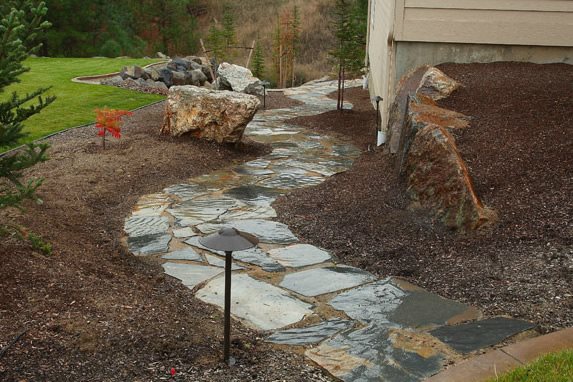
When planning to install a flagstone patio, labor costs are an important consideration. In general, labor costs can vary based on the size of the project, the type of stone being used, and the installation method chosen.
For example, a 200-square-foot flagstone patio may cost less in labor than a 400-square-foot patio, as there is less work to be done. Similarly, the installation method can also impact labor costs. Wet-laid flagstone patios may require more time and expertise to install, leading to higher labor costs than dry-laid patios.
In addition, the type of stone being used can also impact labor costs. Irregular shapes and sizes of flagstone may require more time and effort to install, and thus may result in higher labor costs. However, the wide variety of shapes and colors available in flagstone means that there is sure to be an option that fits any aesthetic preference and budget.
It’s also important to consider the cost of materials when factoring in labor costs. While the cost of flagstone can vary based on the type of stone and the amount needed, it’s important to use high-quality, durable material for a long-lasting patio. Material costs can impact labor costs, as well, as some installation methods may require more materials than others.
National averages for labor rates typically range from $10-25 per square foot for a flagstone patio installation, with an average cost of around $15 per square foot. However, it’s important to obtain quotes and do research to find a reputable and experienced installer who can provide a more accurate estimate based on your specific project needs.
Overall, when considering the cost of a flagstone patio installation, labor costs are an important factor to keep in mind. By researching and planning ahead, it’s possible to create a beautiful and functional outdoor space that fits within your budget.
Personal Preferences
When it comes to creating the perfect outdoor living space, personal preferences play a major role in the decision-making process. This is especially true when it comes to choosing the materials for a patio or walkway, such as natural stone options like flagstone or concrete pavers.
While factors such as budget and functionality will play a role in the ultimate choice of material, personal preferences should not be overlooked. From the color and texture of the stone to the overall look and feel of the finished product, personal taste should be taken into consideration to ensure that the outdoor space accurately reflects the homeowner’s style.
One popular option for those seeking a rustic, natural look is flagstone. With its wide variety of colors and irregular shapes, flagstone offers a unique, organic feel that complements a wide range of outdoor settings. However, those who prefer a more uniform appearance may opt for traditional concrete pavers, which offer a sleek, modern look and can be easily customized to fit a particular color scheme or aesthetic.
Other personal preferences that may come into play include the size and layout of the patio or walkway, such as whether to use larger pieces of stone or smaller, more intricate pieces. Homeowners may also choose to incorporate decorative elements, such as patterns or borders, to add visual interest and further personalize the space.
Ultimately, the goal is to create an outdoor living area that not only meets functional needs but also reflects the homeowner’s individual style and tastes. By taking personal preferences into account throughout the decision-making process, homeowners can create a patio or walkway that is truly one-of-a-kind and a source of pride for years to come.
Installation Method
When it comes to creating a beautiful and functional outdoor living space, choosing the right installation method is crucial. The installation method you choose will impact not only the appearance of your patio or walkway but also its longevity and durability.
One popular installation method for flagstone patios is the wet-laid method. This involves laying the flagstone on a bed of mortar and then grouting the spaces between each stone. The wet-laid method is ideal for creating a patio that will stand up to heavy foot traffic, as the mortar helps to hold each stone firmly in place.
Another option is the dry-laid method, which involves laying the flagstone on a compacted base of gravel or sand without the use of mortar. The stones are carefully laid out and fit together tightly to create a stable surface. Dry-laid patios are less expensive to install than wet-laid patios since they don’t require the use of mortar.
The installation method you choose will also impact the overall cost of your patio or walkway. Labor costs associated with wet-laid patios are usually higher since they require more time and skill to install. In contrast, dry-laid patios are less time-consuming to install, making them a more affordable option.
When it comes to choosing an installation method, it’s important to consider the particular needs of your outdoor space. If you’re looking for a low maintenance patio that can withstand heavy traffic, the wet-laid method might be best. However, if you’re working with a smaller budget and aren’t concerned about heavy traffic, the dry-laid method might be the way to go.
Ultimately, the installation method you choose will depend on a variety of factors, including the size of your patio, your budget, and your personal preferences. By working with a professional stonemason, you can determine which installation method is right for your outdoor living space and enjoy a beautiful and functional patio or walkway for years to come.
Average Cost of a Flagstone Patio

Flagstone patios are a luxurious addition to any outdoor space, but they can also be quite costly depending on various factors. The cost of a flagstone patio depends on the square footage, type of stone used, installation method, and labor costs. In general, the average cost of a flagstone patio is around $15 to $30 per square foot, with additional costs for professional installation.
One of the biggest factors affecting the cost of a flagstone patio is the type of stone used. Flagstone is a sedimentary rock that comes in a variety of colors and shapes, including irregular and uniform shapes. Some common types of flagstone include sandstone, limestone, and slate, each with their own unique qualities. The cost of these stones can vary depending on availability and quality, with premium-quality stones costing more.
In addition to the cost of the stone itself, there are also installation costs to consider. The method used to install the flagstones can significantly impact the cost of the project. Wet-laid installation involves using concrete slabs to lay the stones, while dry-laid installation involves laying the stones on a bed of sand or gravel. Wet-laid installation is generally more expensive due to the need for more materials, while dry-laid installation tends to be more affordable.
Labor costs are another important factor to consider when estimating the cost of a flagstone patio. The cost of hiring a professional contractor to install a flagstone patio can vary depending on the experience and location of the contractor. Additionally, the size and complexity of the project can also impact the labor costs.
When it comes to budgeting for a flagstone patio, it is important to take all of these factors into account. While a flagstone patio can be a significant investment, it is also a durable and long-lasting material that can enhance the appearance and value of your outdoor space. With proper care and maintenance, a flagstone patio can provide years of enjoyment and relaxation.
Benefits of Having a Flagstone Patio
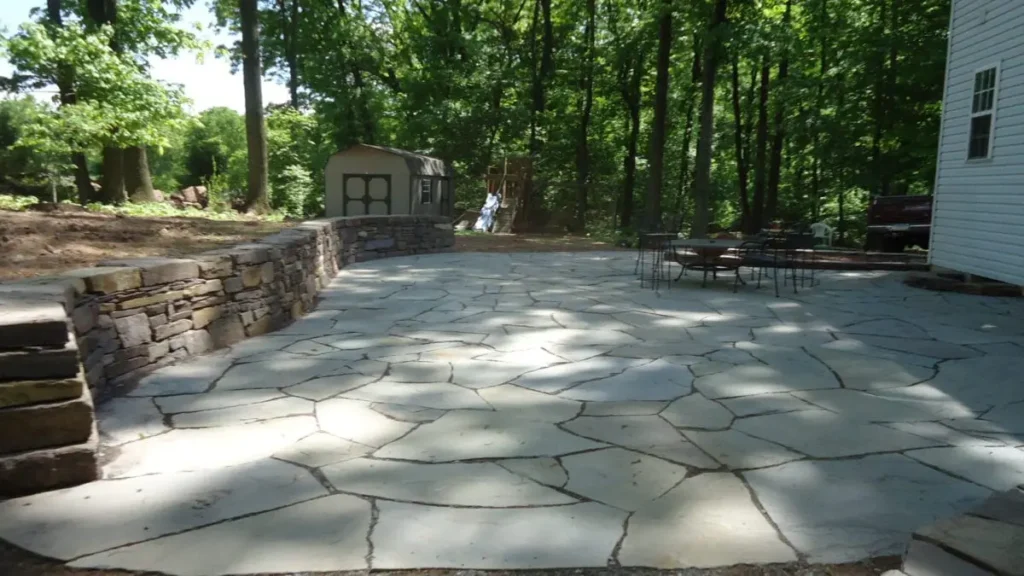
If you’re considering a new patio for your outdoor living space, a flagstone patio may be just what you need. Flagstone is a durable and beautiful natural stone material that provides a variety of benefits for homeowners. Here are just a few reasons why you should consider investing in a flagstone patio.
Durability
Flagstone is a sedimentary rock that is incredibly strong and durable, making it an ideal material for outdoor living spaces. Its natural hardness and durability make it resistant to chipping, cracking, and damage caused by harsh weather conditions, making it an ideal choice for areas that experience extreme temperatures or heavy rain.
Versatility
One of the biggest benefits of flagstone is its versatility. It comes in a wide variety of shapes, sizes and colors, ranging from light gray to brown to blue. This means you can create a unique and customized patio that complements the design of your home and matches your personal preferences.
Low Maintenance
Flagstone requires very little maintenance, making it an ideal choice for homeowners who want minimal upkeep. Because it is a natural stone, it won’t fade or lose its color over time, and its textured surface helps prevent slipping. Additionally, the irregular shapes and sizes of flagstone make it easy to replace individual stones if they become damaged or worn over time.
Adds Value to Your Home
Adding a flagstone patio to your outdoor living space can significantly increase the value of your home. A well-designed and installed flagstone patio adds a sophisticated and elegant touch to your outdoor living area, making it more appealing to potential homebuyers should you decide to sell your home in the future.
Customizable Design
Flagstone patios are highly versatile, allowing for a wide range of creative design options. From adding unique patterns using different colored stones to incorporating curved edges, flagstone patios can add a personalized touch to your outdoor living space.
In conclusion, the benefits of a flagstone patio make it a worthwhile investment for any homeowner. Whether you want added durability, low maintenance, or a customized design, a flagstone patio can provide all of these benefits and more, providing a beautiful and functional outdoor space for years to come.
How to Save Money When Installing a Flagstone Patio
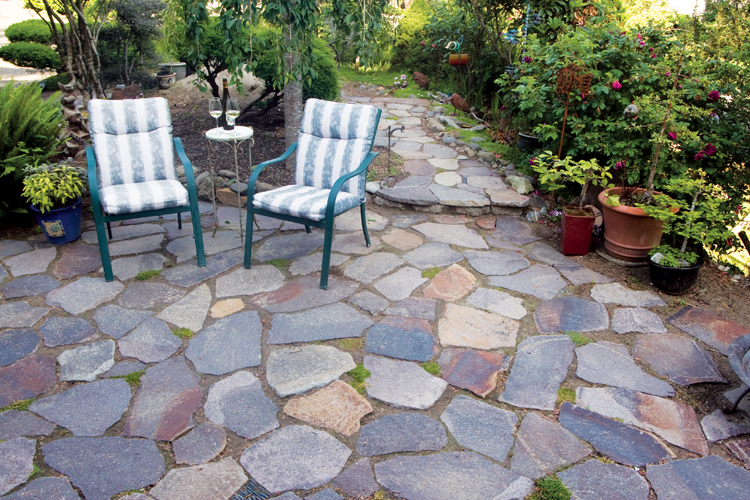
If you’re looking to enhance your outdoor living space with a flagstone patio, you may be concerned about the cost. However, there are a few tips and tricks you can follow to save money on the installation of your flagstone patio without sacrificing quality.
1. Use Dry-Laid Installation Method
Dry-laid flagstone patios are installed without the use of concrete or mortar, which can significantly reduce the cost of labor. With this installation method, the stones are laid on a base of gravel and sand and secured in place with a special flagstone adhesive. This not only reduces labor costs but also allows for easier repairs and replacement of individual stones.
2. Choose Affordable Types of Flagstone
Not all flagstone is created equal, and some varieties can be much more expensive than others. When choosing your flagstone, consider selecting a lower-cost option, such as Pennsylvania bluestone or sandstone. These varieties are widely available and can be purchased at a lower price point than more exotic types of flagstone.
3. Opt for a Smaller Patio Size
The size of your patio will directly impact the overall cost of the project. Choosing a smaller size, perhaps a 200-square-foot flagstone patio instead of a 400-square-foot patio, can make a significant difference in the cost of both materials and labor. You can still create a beautiful and functional outdoor living space on a smaller scale.
4. DIY Some of the Work
While installing a flagstone patio may seem like a project best left to the professionals, there are a few DIY-friendly tasks you can take on to save money. For example, with the help of a friend or family member, you can prepare the patio area by removing grass and other vegetation or laying the gravel and sand base. You can also save on labor costs by doing some of the heavy lifting and moving of materials yourself.
5. Shop Around for Materials and Labor
Finally, one of the simplest ways to save money on a flagstone patio installation is to shop around. Get quotes from multiple contractors and compare them to find the best value. Additionally, look for sales, discounts, or deals on materials, such as flagstone or gravel, to further reduce the cost of the project.
By following these tips, you can enjoy the beauty and durability of a flagstone patio while keeping costs under control. With a little planning and effort, you can create a stunning outdoor space that will be the envy of your neighborhood without breaking the bank.
DIY Vs. Hiring Professional Installers for Your Flagstone Project
Deciding whether to tackle a flagstone project on your own or hire professional installers can be a tough call. While a DIY installation can certainly save you money, it can also be a challenging and time-consuming task. Hiring professionals, on the other hand, can come with a higher price tag, but they can also ensure a high-quality result with less stress and hassle. So, which option is right for you?
DIY installation can be a great way to save money on your flagstone project. By doing the bulk of the work yourself, such as preparing the area, laying the base, and installing the stones, you can cut labor costs significantly. Plus, doing the work yourself can give you a sense of pride and ownership over your outdoor living space. However, before you commit to a DIY project, consider your skill level and available time. While some flagstone installations can be relatively straightforward, others may require specific tools or techniques that you’re not familiar with. Additionally, a DIY project can eat up a lot of your free time, potentially spanning weeks or even months.
Hiring professional installers can come with a higher up-front cost, but can also ensure that your flagstone project is done correctly and efficiently. Experienced installers can handle every aspect of the installation, from preparing the area to laying the stones, using the best materials and tools for the job. Additionally, professionals can handle any difficulties that may arise during the installation process, such as uneven ground or unexpected obstacles. You can trust that when professionals are hired to do the job, they will have the correct tools and supplies to complete the installation quickly, neatly, and correctly the first time.
Ultimately, the decision of whether to DIY or hire professionals for your flagstone project depends on your priorities and preferences. If you’re looking to save money and have the time and skillset needed for the project, DIY can be a fun and rewarding choice. But, if you want a high-quality installation with minimal stress and the assurance of a professional finish, hiring experienced installers might be the right choice for you.

